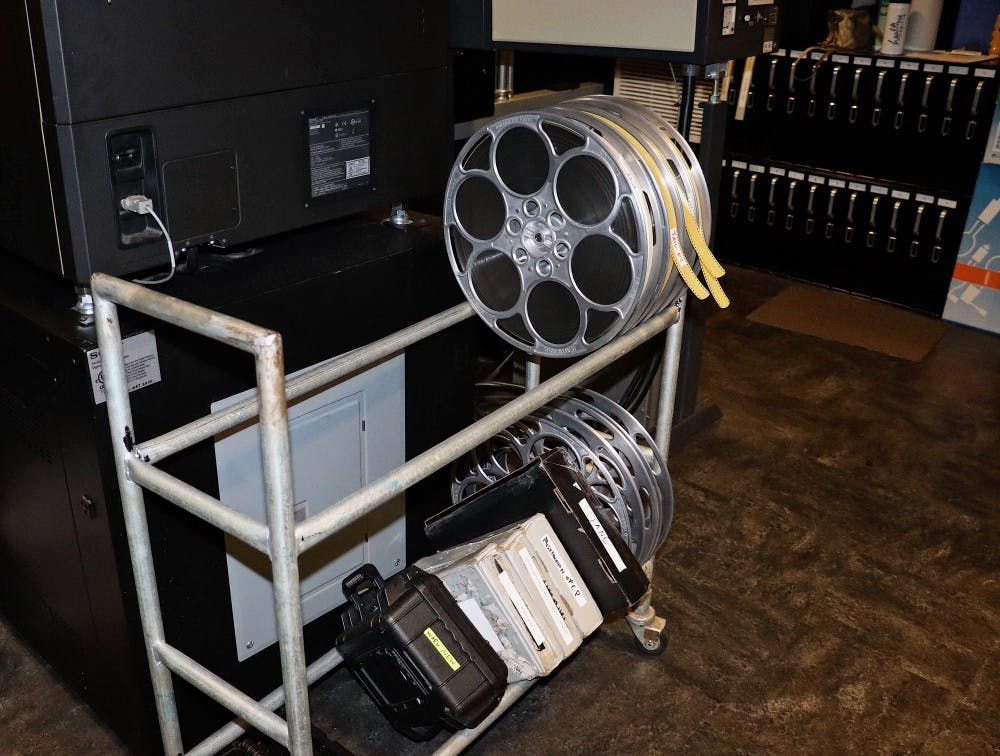In a room somewhere beneath its grand auditorium, IU Cinema’s technical director Barbara Grassia toils away at her desk. It’s a small room, lit with bright fluorescent lights, filled with gadgetry and film paraphernalia. Racks of empty reels line the walls, and on a small white desk in the corner, is a rig to hold reels for her inspection.
Before the lights can dim, before the red curtain rises and before the cinema’s dual projectors can whir to life to send a film’s images dancing across the silver screen for the Aug. 23 showing of the 1985 film "White Nights," Grassia does her job.
On the floor, a storage case sits open, containing reels of film. One of Grassia’s responsibilities as the cinema’s technical director is to check old film reels to ensure they’re in shape for presentation.
Painstakingly, Grassia feels for imperfections in the celluloid with her gloved hand, winding foot after foot from one reel to another. A light and a loupe – a special magnifier specifically for this job – on her desk enable her to inspect the images more closely to ensure that the quality is confirmed or that the proper projectionist cues are in place.
Grassia repeats this process of scrolling through every reel of every movie the cinema projects, checking for image and sound track quality, along with imperfections.
In addition to her qualitative observations, Grassia also records details for projectionists, letting them know what to expect.
While inspecting of the print of “White Nights,” Grassia finds a problem.
The celluloid has been damaged. On either side of the image strip of the film are a row of square sprocket holes that guide the film through the projector’s fast-moving sprocket rollers. In multiple areas, the edge of the film has fallen off, leaving the teeth without a secure gripping point.
As the reels fly through the projector, this is what could result in breakage, jamming or other problems.
Grassia and the IU Cinema’s Programmers weigh the pros and cons. A 35mm print is undoubtedly more visually appealing than a digital projection, but film breakage is a risk. She knows she can repair existing damage, but cannot guarantee that other areas will hold.
The verdict: go for it.
As patrons sat in the auditorium of IU Cinema, transfixed by the climactic escape sequence of “White Nights,” Grassia and another of the cinema's projectionists stood ready and prepared.
At 136 minutes, the film for “White Nights” measures a whopping 12,240 feet, stretched out over eight reels. The worn-and-torn 35mm film risks breakage with continued projection.
Film is a complex beast; for every second of movie are 24 still images fed through a series of sprockets and rollers. In front of a bulb, an intermittent roller freezes motion once per frame, 24 times per second, 1,440 times per minute, 86,400 times per hour.
In the best-case scenario, nothing will go wrong. But sometimes things do. One possibility is that the film becomes jammed in the projector, disrupting a taut sequence.
The most unlikely scenario is that the film burns in the projector. In a split second, the image onscreen would combust in a sickly eruption of bubbling brown followed by only white.
The cinema’s projectionists can shut off the film projector in a moment’s notice so as to prevent the celluloid from burning.
They also ensure they have a backup in place on the digital projector, which plays two minutes behind the film reels. Should the projected image freeze, tear or burn, they’ll simply flip a series of switches, and the image will return.
The absorption that gives the cinema its allure will be momentarily broken by a problem, but the show will go on. The bigger issue is that a rare 35mm print of this classic film could be damaged.
“If the film had broken, we knew that without having to do anything, like bring up the lights, we would just deal with the film and the projector," Grassia said. "And then while I was doing that the other projectionist would switch us to the other content."
In the eyes of Jon Vickers, the cinema’s founding director, the projectionist is the final link of the filmmaking chain.
“Projectionists play a part in helping make those experiences immersive and memorable," Vickers said. "When projecting on film, there are so many fine details for which the projectionist has control over. Neglect of any one of these can alter the experience.”
As the audience watches “White Nights,” projectionists prepare for the worst. But it proves to be unnecessary.
The celluloid glides through the projector with all the grace of the dancers onscreen, mounting their daring escape. The image does not jam, nor does it burn. The backup digital copy remains a backup, unused and unneeded.
The audience’s experience is joyous, untainted. The film reels can be returned and passed on time and time again.
After all, what good is a story that can’t be passed on?




